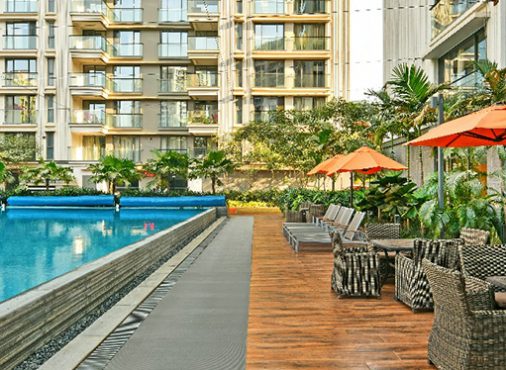Living in groups or a community is a concept as old as the existence of society, but it has regained its importance in contemporary India. People have always lived together in standard groups, halls or apartments, from the traditional village setting to the modern housing complex.
Due to the increasing rate of urbanisation and shifting family structures that have become prevalent in India, there is a growing interest in community living to address some social, economic, and environmental issues.
Community living not only helps to create a culture of care and camaraderie but also encourages the practice of eco-friendly measures in a society that is gradually becoming more and more self-focused.

Community Living Meaning
Community living involves people or families living in one area, sharing the everyday use of property and facilities, making decisions, and attending to social matters jointly. Living together is more than mere habitation; it focuses on cooperation, complementarity, and people’s well-being.
At its core, the meaning of community living involves:
- Shared Spaces: People can access common-use areas such as gardens, playgrounds, or recreation areas.
- Collective Resources: It is common for members of such groups to pool together to acquire some resources with a view to sharing, as this is cheaper and conserves the environment.
- Social Engagement: Strong personalities breed from interaction and day-to-day community activities.
- Cooperative Governance: Community involvement is included in all developmental activities that are done in the community.
- Mutual Support: Members help each other in different situations in their daily lives, forming a helping system.
Types of Community Living in India
Community Living in India is of various types. Some of them are highlighted as under:
-
Co-living Spaces for Young Professionals
Co-living spaces have become widely used among millennials or young employees in large cities in India. Such accommodations combine individual and collective home arrangements and services, including Internet access, cleaning services, and shared lounges.
They are intended for millennial and Gen Z populations as a more efficient and less expensive way of housing than rental properties. Social, spatial, and temporal focus is on the primacy of operations, community, and convenience.
-
Senior Citizen Communities
Senior citizen communities are residential establishments opened and designed to accommodate people of old age. Such communities offer security and care, with health centres, leisure, and services for the elderly.
They deal with the ability of the patients to lead a dignified and comfortable life with the possibility of social contact, protection, and autonomy. These may comprise assisted living, health care, and health promotion.
-
Multi-generational Housing
Multi-generational housing is a concept in which the architectural structure is designed to accommodate more than one generation of a particular family. This type of living fosters family unity and assists relatives in supporting each other throughout the generations.
These homes are planned to support privacy and affiliation since many residents are likely to dwell in them most of the time. In India, joint family systems have been traditionally prevalent, and multi-generational housing is a contemporary solution that meets modern requirements.
-
Gated Communities
Gated communities refer to apartment buildings or residential neighbourhoods enclosed by fences, gates, and access control systems to enforce privacy. Such communities are preferred by middle to upper-income earners, and facilities like parks, gymnasiums, swimming pools, clubs, etc. are usually provided.
Depending on the design and concept, the lifestyle in gated communities encompasses privacy, suburbia, and elitism.
-
Eco-friendly Townships
Eco-friendly townships have been established as towns or cities where environmental conservation is central. These communities teach eco-sustainability by providing green energy, water, eco-disposal, and structures.
The emphasis is on limiting man’s environmental impact, with concern for quality living standards. People living in environmentally friendly residential areas are generally drawn towards such estates because of their health-consciousness and ecological conservation.
Read Also: Luxury Bedroom Interior Design in India
The Benefits of Community Living
Community living is a sensitive prospect with several social, economic, and environmental benefits, which is why many people embrace it. Here’s a brief look at the key benefits that enhance the quality of life in such settings:
-
Enhanced Social Interactions and Community Support
People who live in communities get to mingle and have a sense of fraternity, which eventually leads to mutual support and cooperation. It helps to overcome loneliness and provides feelings of belonging to some community among residents.
-
Improved Safety and Security
Staying in a community offers added security. The areas are fenced and guarded, and watchful neighbours help secure the premises and protect the occupants.
-
Access to Shared Amenities
All-inclusive facilities such as fitness centres, swimming pools, parks, and clubhouses enhance the quality of human life. They provide readily accessible recreational facilities and support healthy living in society.
-
Cost Efficiency Through Shared Resources
Stakeholders in this type of housing manage their expenses collectively by sharing services like maintenance, utilities, and amenities; hence, people who live in groups are more financially savvy than those who live alone.
-
Environmental Benefits and Sustainability
Communal living systems, for instance, involve using common utilities, green areas, and environmentally friendly structures and systems, reducing human beings’ adverse effects on their environment.
How to Choose the Right Community Living Space?
It is, therefore, essential to know which community living space suits him or her to have a good lifestyle. Here are vital factors and tips for adapting as a new resident:
- Location: The availability of employment, educational, health, and transport facilities in the community is highly desirable. A neighbourhood’s accessibility has a profound impact on convenience and comfort.
- Amenities: Consider every available opportunity, such as the presence of a health facility that may include a gym, park, swimming pool, or community centre. Ensure that those you choose are in tune with your lifestyle and requirements.
- Demographic: Take into account the community’s population density or distribution. As the discussions about families, young professionals, and seniors have shown, the company of like-minded people can dramatically enhance the quality of life.
Tips for New Residents
- Engage with Neighbors: Find your niche and engage in the community to properly connect and make yourself comfortable.
- Respect Community Rules: It will be advisable to get a good feel for the conduct in the community to fit in and live in harmony.
- Be Open to New Experiences: It is helpful to adjust to the given community culture and accept the opportunity to make new friends and participate in mutual activities.
Read Also: What is Stilt Parking? Benefits and Uses
Common Misconceptions About Community Living
Many myths and fears are generally associated with community living. Let’s debunk some common misconceptions:
Myth 1: Invasion of privacy
For many, living in a community violates the right to privacy. Indeed, contemporary community environments permit socialisation, although they afford seclusion and privatisation with individual spaces and well-planned denominations.
Myth 2: Lack of Independence
Some fear that they will sacrifice their freedom if they try to live in a community. But this is because most communities are designed for independent living, and help is provided only when required.
Myth 3: Limited Social Diversity
Community residential areas are defined and assumed to be of a single or similar nature. Many communities can be diverse, accommodating persons from different origins and promoting diversity.
Myth 4: High Costs
Everyone agrees that living in a community is costly. Even though some options are paid, many communities provide affordable solutions using shared facilities and access to services so that more people can use them.
Living in a community provides convenience, social contact with neighbours, security, and shared facilities. Regarding the cost, the advantages of such residing are apparent. If you are a beginning career worker, a middle-aged or senior citizen, or a family, the best community can fulfil your needs and help improve your quality of life.
Are you interested in affordable residential properties or properties under 7 crore? Consider community living today with Rustomjee to get the space that suits your needs and economic well-being.
FAQs
- What is the concept of community living?
In its simplest essence, community living is living in a community that demands people to participate actively. It is thus distinct from dwelling in a town or city with other people with whom one cannot share time and engage even in minimal conversation.
- Why choose a senior living community?
In senior living communities, one does not struggle to interact with neighbours or staff members daily, negating feelings of loneliness. People can attend events or functions with their neighbours to interact and meet new people over a meal in the dining area or during a walk around the facility.
- What are the benefits of community living?
Living in a community offers companionship and social support, shared duties and cooperation, access to resources and utilities, increased security, cultural interchanges, and diversification.
- Is community living helpful for the environment?
While few individuals choose community living due to environmental concerns, there could sometimes be added value for the environment.
For example, when a community lives together, resources are shared instead of used individually, such as discarded food. Moreover, energy bills will also be reduced where individuals congregate and share spaces, and so forth.
- Can community living be advantageous?
It is advantageous if one feels like living among people, most of whom share certain aspects of your life that you consider most vital. However, certain types of communal living may mean that the participants are somewhat isolated from society. In open models of community life, people receive all the positive aspects of living in a community and none of the negative.








